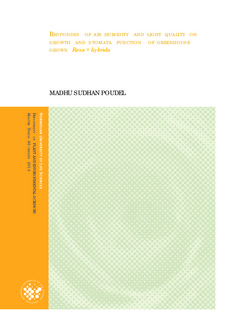| dc.description.abstract | Single node stem segment with one mature leaf of Rosa x hybrida, cv. Toril were grown in
chambers. Plants were exposed to 100 μmol m-2 s-1 for 20 h day-1 followed by a 4 h dark period
and supplementary light was provided by LED (20% blue light and 80% red light), HPS and
HPS+UV-B Lamp. Each light source was provided by moderate (60%) and high (90) RH in
different chambers. The UV-B light was provided 1 hour twice a day, in the middle of the dark
period and in the middle of light period. The UV-B treatment was given in combination with
HPS lamp as supplementary light. Thus, the main aim of the study was to investigate if light
quality can improve the stomata function under high RH.
The experiment was divided into two parts, first HPS and LED and seconds the effect of UV-B.
In the first experiment, the stems were significantly longer under HPS compared to LED, under
moderate RH, LED suppressed pedicel length and induced shorter pedicels compared to HPS.
The number of flowers and leaf area was not significantly affected by either RH or light quality.
Comparatively, moderate RH had significantly more leaves per stem higher, dry weight of stem
and higher dry weight of pedicle length and flower compared to high RH, but no significant
effect of light quality was found on these parameters. At high RH, gsw was still high during
darkness for both HPS and LED and indicate lack of dark induced closure. However, LED
reduced the conductance under high RH during light and darkness indicating reduced stomatal
aperture and a better closure capacity when grown with LED. Moderate RH had a lower
conductance under LED compared to HPS but both light qualities induced closure in darkness.
Detached leaves from plants grown at high RH showed a rapid water loss compare to leaves
grown at moderate RH. Stomatal length and pore aperture were significantly higher in plants
grown at high RH compared to moderate RH. Plants developed at high RH with LED showed a
desiccation tolerance than plant grown under high RH and HPS. In second experiment, both high
and moderate humidity showed a similar pattern with the conductance decreasing through the
time of one hour exposure of UV-B. The UV-B did not induce better closure rather the opposite
was found and plants developed at high RH and exposed to UV-B had a higher water loss in a
desiccation test. Comparison of flavonoids and anthocynins on high and moderate humidity of
iii
UV-B treatment was found to be non-significant. Hence, the conclusion of this study is that light
quality can be used a tool to improve the stomata function under high RH. By using LED with
more blue light (20%) a better dark induced closure was found and a better desiccation tolerance
was found compared to the traditional HPS lamps. The use of UV-B did not improve the stomata
function under high RH but rather induced an even higher water loss. The interactive effect
between light quality and air humidity needs further investigation but light quality can be one of
the useful tools since LEDs are believed to be an important light source in greenhouse in the
future. | no_NO |
